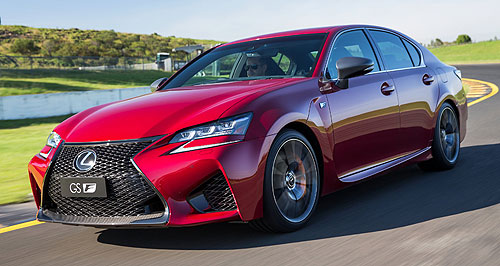Driven: Lexus undercuts rivals with GS F
BY DANIEL DEGASPERI | 23rd Feb 2016

Its debut marks the first time Lexus will compete in the full-sized sports sedan segment and the GS F is only the fourth vehicle to emerge from the brand’s F performance division – following the superseded IS F compact sedan, LF-A supercar, and the current RC F coupe.
The GS F costs less than the Audi S6 ($169,510) and BMW M5 Pure Edition ($185,000), a duo of sedan competitors with vastly different characteristics ranging between executive-express luxury and sports respectively.
For this reason, Lexus Australia head of product planning Mark Dobson struggles to find a natural competitor for the GS F.
“It’s hard to pick what you’re comparing against,” he told GoAuto at the national media launch of the GS F in Adelaide.
“First of all you start with price, so you go okay, the car costs $148,000 – how far away from that price up or down do you go and still call it a competitor? If you take other competitive models around that price, there are other competitors – BMW, Audi – who have models in that price range, but then you look at what (equipment) you’re getting.”Standard equipment on the GS F is extensive, and includes a sunroof, keyless auto-entry and start, 12.3-inch colour display with satellite navigation and concierge services, 17-speaker Mark Levinson audio system, colour head-up display, tri-zone climate control, heated leather steering wheel, front and rear heated seats with leather/Alcantara trim and power rear sunshade.
Safety equipment includes 10 airbags, pre-collision warning system, active cruise control, blind-spot monitor, lane-keep assist and adaptive automatic high beam.
“The competitors go one way with the type of engine they put in and the styling, and Lexus goes another way, and we’re trying to attract a different style,” Mr Dobson added.
The GS F uses a 5.0-litre naturally aspirated V8 engine producing 351kW of power at 7100rpm and 530Nm of torque between 4800rpm and 5600rpm. It has a redline of 7300rpm and an eight-speed automatic is the only transmission available. The 1825kg sedan can race from 0-100km/h in 4.6 seconds.
The S6 and M5 Pure Edition utilise downsized turbocharged V8 engines to achieve 4.4s and 4.2s 0-100km/h claims respectively.
If forced to pick a rival, Mr Dobson said, “I’d have to say it’s the Audi A6.” However he said he believes the GS F is a four-door alternative to the RC F compact coupe launched last year.
“In other particular models we can definitely pitch against one car, but I’d say this car (GS F) is benchmarked on the RC F,” Mr Dobson said.
“They built the RC F and then said now we’re going to make this four-door sedan (and) what do we want to make it like for performance? Well, okay, let’s benchmark the RC F.”“I think the Lexus F buyer is the enthusiast driver,” added newly appointed Lexus Australia chief executive officer Peter McGregor.
“The reason we offer the two vehicles, the RC coupe and the GS sedan, is because some people prefer to have that in a two-door version with a shorter wheelbase, and some people prefer to have it in a four-door sedan that has the ability to take five people – or four people in comfort – with a good amount of luggage room as well,” he added.
“So it can serve both purposes in the GS F for the enthusiast driver.”Mr Dobson said he believes the GS F will also act as an aspirational vehicle for, “People who want to make a statement – I love ‘natural aspiration’ for example.”He also said that many former buyers of an HSV product may “absolutely” look at buying a GS F.
“At out drive day we had an HSV as a competitor car,” Mr Dobson added. “Maybe there are a few people who aren’t loyalists.”Lexus predicted sales volume for the GS F of 30 units per year, however Mr Dobson confirmed that 26 are already pre-sold.
“We thought 30 per year [but] it looks like it’s going to smash our conservative prediction,” he said.
Compared with the four-year-old GS sedan, the GS F increases the use of high-tensile steel and adds underfloor structural bracing to improve torsional rigidity. The multi-link front and rear suspension are revised with ZF Sachs fixed dampers, new springs and stabiliser bar, and forged aluminium control arms to reduce weight.
Driver-selectable modes include Eco, Normal, Sport S and Sport S+ that alter parameters for the electro-mechanical steering, throttle and transmission response and engine output.
Sport S+ includes a stability control function called VDIM Expert that allows controlled drifting in track conditions. The stability control can also be disengaged independently. The systems work with a Torque Vectoring Differential (TVD) to prioritise torque to one particular rear wheel, depending on the conditions.
As standard the GS F includes 255mm front/275mm rear 19-inch Michelin Pilot Super Sport tyres and 380mm six-piston front/345mm four-piston rear Brembo brakes with slotted rotors.
Options include “high grade” polished 19-inch wheels and carbon interior ornamentation each costing $2500.
A higher-specification GS F is also available for $151,700 plus on-road costs, with the single addition of semi-aniline full leather trim with front seat ventilation.